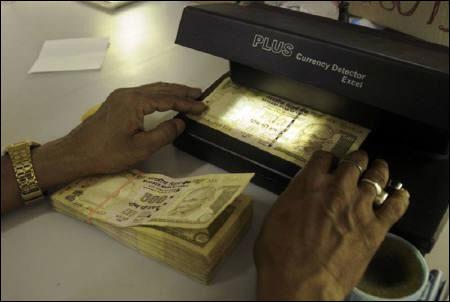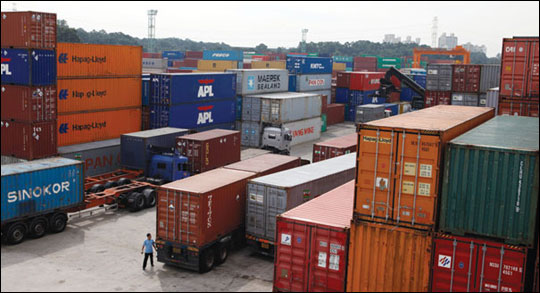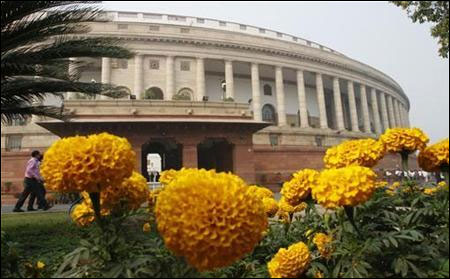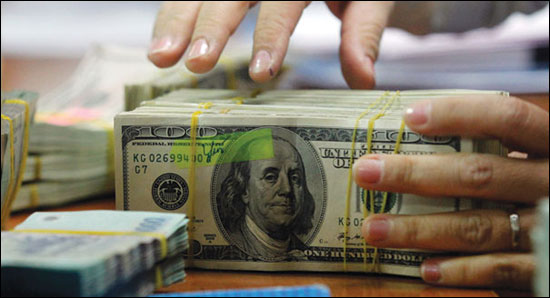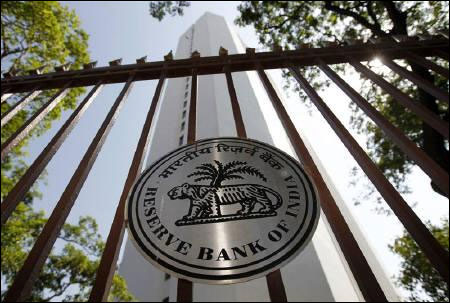 | « Back to article | Print this article |
Why the rupee is likely to hit 60/UD$
Coupled with the growing trade deficit and current account deficit, the rupee is depreciating on account of other factors as well.
The combination of circumstances that contributed to the fall in the value of the rupee vis-a-vis the US dollar was predictable to a considerable extent. But the sharp and sudden fall in the exchange rate of the Indian currency in relation to the American greenback has taken many by surprise.
As the rupee appears inexorably headed towards breaking the Rs 55=$1 barrier in the near future and perhaps touch the Rs 60=$1 mark, the big question that arises is whether this is good for the country.
Under certain circumstances, currency depreciation may not be such a bad thing if it results in exports going up thus bringing down the trade deficit (the difference between the value of exports and the value of imports) as well as the current account deficit (the gap between inflows and outflows of foreign currencies) and the capital account deficit (or the difference between the inflows and outflows of capital, both in the form of portfolio investments in stock exchanges and foreign direct investments) in the balance of payments.
But on this occasion, the answer is unequivocally clear: the fall in the value of the rupee portends ill for the Indian economy.
Click on NEXT for more...
Why the rupee is likely to hit 60/UD$
Export growth has been sluggish and is likely to remain that way for a while. Imports have been buoyant and since India is currently heavily dependent on imports which cannot be easily curtailed, the trade deficit and the current account deficit will both be difficult to control thereby ensuring that pressures on the rupee to depreciate will persist.
Coupled with the growing trade deficit and current account deficit, the rupee is depreciating on account of other factors as well.
These include the fall in the international value of the Euro on account of the sovereign debt crisis and the double-dip recession in Europe; the drying-up of inflows from foreign institutional investors; the slowing down of the rate of growth of the economy in general and industrial output in particular; and stubbornly high inflation at home.
Click on NEXT for more...
Why the rupee is likely to hit 60/UD$
Compounding the situation, the Union government is in a state of paralysis at present, buffeted by scandals and constrained by compulsions of coalition politics.
All these factors have come together to reinforce expectations of a further decline in the exchange rate of the rupee.
In the financial year that ended on 31 March, India's trade deficit jumped by a phenomenal 56 per cent over the previous year to touch a level of $185 billion.
This jump in the trade deficit was a consequence of the rate of growth of exports halving after growing by a record 41 per cent in the previous year, 2010-11. In these two years, the value of imports rose by nearly one-third.
In the period between April and December 2011, the current account deficit widened to an all-time high of almost $54 billion or around 4 per cent of the country's gross domestic product (GDP).
Assuming this trend is continuing, this proportion is currently believed to be close to 4.5 per cent of GDP, which will be difficult (if not impossible) to sustain in the medium-term.
Click on NEXT for more...
Why the rupee is likely to hit 60/UD$
It must be noted that the current account deficit would have widened further had inflows on the "invisibles" account in the form of transfers of funds from abroad – largely, remittances from workers – not remained rather healthy.
Dr Biswajit Dhar, Director General, Research & Information System for Developing Countries, told Rediff.com that the "structural infirmities in the Indian economy are now showing with the rising current account deficit being driven by the sharp rise in the trade deficit".
He expressed concern that "no efforts are being made by the government as well as by industry to look for and obtain new export markets" and lamented that "despite the depreciation of the rupee, the competitiveness of Indian exports has not improved".
Dr Dhar pointed out that as part of its Look East policy, the Indian government had recently signed a number of free trade agreements with the Association of South-East Asian Nations (ASEAN), Japan and South Korea, "but our exporters have not been particularly successful in penetrating the markets of these countries". (Korea's share of exports from India has actually come down.)
He adds that India has also not been able to substantially increase exports to fast-growing African countries like Ethiopia. After the India-Africa summit in 2008, another took place in 2011 during which Prime Minister Manmohan Singh announced a $5 billion line of cheap credit to facilitate exports from India. "Unfortunately, this credit facility is not being fully utilised," says Dhar.
Click on NEXT for more...
Why the rupee is likely to hit 60/UD$
It is understandable if India's exports to the West are shrinking or disappearing given the deepening of the recession in Europe. But what is worrisome is that after over three decades, the government of China in March scaled down its projection of GDP growth during 2012 from 8 per cent to 7.5 per cent.
The news is especially bad when one considers the fact that China is India's biggest trading partner and total two-way trade between the world's two most populous countries has gone up almost tenfold over the last decade or so.
One way in which India could have curtailed its current account deficit was by reducing imports. But that does not seem feasible today.
India currently imports 80 per cent of the country's total requirements of crude oil and oil accounts for around one-third of the country's total annual imports (which stood at $489 million in 2011-12).
The next big item in the country's import basket is gold (which the government is trying to curb). India also imports roughly half of the edible oils it consumes.
Click on NEXT for more...
Why the rupee is likely to hit 60/UD$
In recent weeks, international prices of crude oil have eased a bit but the country has not been able to gain on account of the softening of oil prices because of the depreciation of the rupee.
Even if the higher prices of imported crude do not immediately translate into higher prices of petrol, diesel and cooking gas but increase so-called "under recoveries" or losses being incurred by government-owned oil refining and marketing companies like Indian Oil Corporation, Hindustan Petroleum and Bharat Petroleum, the rise in the import bill of crude oil in rupee terms represents a classic case of India "importing inflation".
Click on NEXT for more...
Why the rupee is likely to hit 60/UD$
The same phenomenon also explains the sharp rise in the prices of edible oil because the rupee value of imported palmolein has risen disproportionately over the last year.
Adding to the downward pressures on the rupee, foreign institutional investors in the country's stock exchanges became net sellers in April as they had in August and September 2011.
Even exporters of computer software and information technology enabled services, who should have been delighted that their rupee earnings are going up because of the relative rise in the value of their profits designated in US dollars, are not exactly overjoyed.
The National Association of Software and Services Companies (NASSCOM) stated: "More than depreciation, the volatility of currency movement is a concern that needs to be tackled since it hinders the planning process for the Indian IT-BPO (information technology-business process outsourcing) industry."
Under the circumstances, a number of economists (including the head of the Prime Minister's Economic Advisory Council Dr C. Rangarajan) have urged the Reserve Bank of India to actively intervene in the foreign exchange market to shore up the value of the Indian currency by selling the American greenback.
Click on NEXT for more...
Why the rupee is likely to hit 60/UD$
The official position of the RBI on intervening in the currency market can be summarized in the following statement made on 11 December 2011 by the central bank's Deputy Governor Dr Subir Gokarn:
"Not using reserves to prevent currency depreciation poses the risk that the exchange rate will spiral out of control, reinforced by self-fulfilling expectations. On the other hand, using them up in large quantities to prevent depreciation may result in a deterioration of confidence in the economy's ability to meet even its short-term external obligations. Since both outcomes are undesirable, the appropriate policy response is to find a balance that avoids either."
The RBI has over the last few months drawn down the country's total foreign exchange reserves (including currency, gold and special drawing rights issued by the International Monetary Fund that are sometimes called "paper gold") from around $300 billion to just over $290 billion.
In addition, the RBI has relaxed caps on interest rates applicable to foreign currency non-resident deposits. On 10 May, the RBI directed exporters to immediately cut their dollar holdings by half and expeditiously bring back their dollar-designated earnings.
There is a case for the RBI to offload more dollars not only to check "volatility" but also to prevent a sharp fall in the external value of the rupee. But the country's apex monetary authority can do that much and no more to keep the Indian currency strong when there are strong and secular pressures, both internal and external, to depreciate the rupee further.
(The writer is an independent journalist and educator.)
